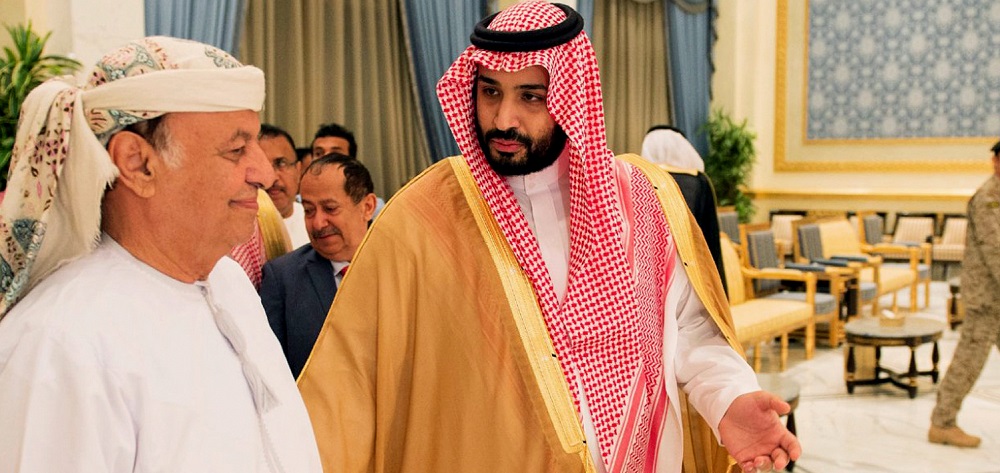
Saudi Arabia is Gradually Running out of Money, the Beginning of the End
YemenExtra
Y.A
“Saudi Arabia needs the initial public offering (IPO) of its state oil company to be successful as it needs to attract outside investment and, frankly, it needs the money,” the former chief of the CIA David Petraeus told CNBC Thursday. “It’s a fact that Saudi Arabia is gradually running out of money, they’d be the first to acknowledge that the sovereign wealth fund has been reduced, it’s somewhere below $500 billion now,” Gen. David Petraeus, who is currently chair of the KKR Global Institute, told CNBC’s Hadley Gamble in Abu Dhabi.
Aramco has not yet revealed all the details of the size and scale of its share offering but said last weekend that it will sell up to 0.5% of its shares to individual investors. A final offer price, as well as the number and percentage of company shares that will be sold, will be determined in early December. Analysts’ valuations of the company have varied from $1.2 trillion to $2.3 trillion. Saudi Arabia is going to float a small portion of its state oil giant Saudi Aramco, the most profitable company in the world, in December. The IPO was first flagged in 2016 by the now-Crown Prince Mohammed bin Salman. He said then that he believed the company was worth around $2 trillion. Bloomberg reported that a variety of bank valuations gave the oil-giant a wide range, roughly between$1.2 trillion and $2.2 trillion.
Forbes magazine considered the investment in Aramco surrounded by high risks, which made the countries and investment companies, refraining from investing in them. Aramco was hit by an air strike last September by the Yemeni Armed Forces, which stopped about half of the kingdom’s oil production. It lost its safe environment required by investments. This led Fitch Ratings to announce that it downgraded the credit rating of Saudi Aramco from A + to A, “the downgrading also took into account rising geopolitical tensions in the region, but also the country’s continued fiscal deficit, among other factors,” the statement explained.
In addition, as Forbes sees, the absence of a safe investment environment in Saudi Arabia was exposed after the Saudi Crown Prince arrested dozens of Saudi billionaires. He put them in fancy prison at the Ritz-Carlton Riyadh without any legal justifications. He shook down his guests for $100 billion in assets with no legal due process whatsoever, therefore, it is difficult to flow foreign capital into an investment environment that is not well treated and protected by the rule of law.
“The bottom line is that they need the money, they need that outside investment that is crucial to delivering ‘Vision 2030’ which cannot be realized without outside investment. This is just one component of a number of different initiatives that they’re pursuing to try to attract that outside investment,” Petraeus added.
Saudi Arabia is going to float a small portion of its state oil giant Saudi Aramco, the most profitable company in the world, in December. The IPO was first flagged in 2016 by the now-Crown Prince Mohammed bin Salman. He said then that he believed the company was worth around $2 trillion. The listing is seen as part of the crown prince’s “Vision 2030” program of economic and social reforms designed to diversify the kingdom’s economy and reduce its dependence on oil.
In a new indicator of the failure of the economic transformation plan from reliance on oil in Saudi Arabia, called “Vision 2030”, the US network addressed a report on the International Monetary Fund, talking about the disappointment of the global economy in the performance of the Saudi economy. Bloomberg quoted Saudi Arabia’s economic growth forecast for 2019 as the fifth time it slips in a short period. It is one of the worst economies in terms of economic growth, according to a report released by the International Monetary Fund (IMF).
Saudi Arabia’s economy is still largely reliant on oil exports, and lackluster oil prices (a barrel of Brent crude is currently priced at $63) have prompted the country’s budget deficit (the amount by which its spending exceeds its revenues) to widen. In 2018, the budget deficit was forecast at around 136 billion riyals (or around $36 billion), according to the kingdom’s Ministry of Finance. It’s expected to be a similar amount in 2019. And in 2020, the kingdom expects the deficit to widen to $50 billion, the kingdom’s finance minister said in October, according to Reuters.
In August, Aramco announced its mid-term revenue for the first time in its history, noting that it declined in the first half of 2019 to $ 46.9 billion, compared to $ 53.0 billion for the same period last year.
This dark picture of the Saudi economic situation has grown darker, after the World Bank placed Saudi Arabia in the 92nd place out of 190 countries in terms of ease of doing business. It is reported that the economic growth forecast for Saudi Arabia will decline from 1.9% to about zero 0.2 %. Moody’s also downgraded its forecast for Saudi economic growth this year from 1.5% to 0.3%.
It seems that the pace of Saudi Arabia’s acceleration towards bankruptcy is inevitable, even if Saudi Arabia offers Aramco shares at very low prices. In case Bin Salman continues his reckless and unbalanced policies at the internal and external levels. Above he needs to stop his unjustified aggression on the Yemeni People, stop the policy of prone to USA and allowing Trump to milk the Saudi treasury in such a greedy manner. In addition to his adventures in exporting takfiri terrorism to various parts of the world, which cost the Saudi treasury huge money, to serve the goals of the Zionist.
Source:Websits
